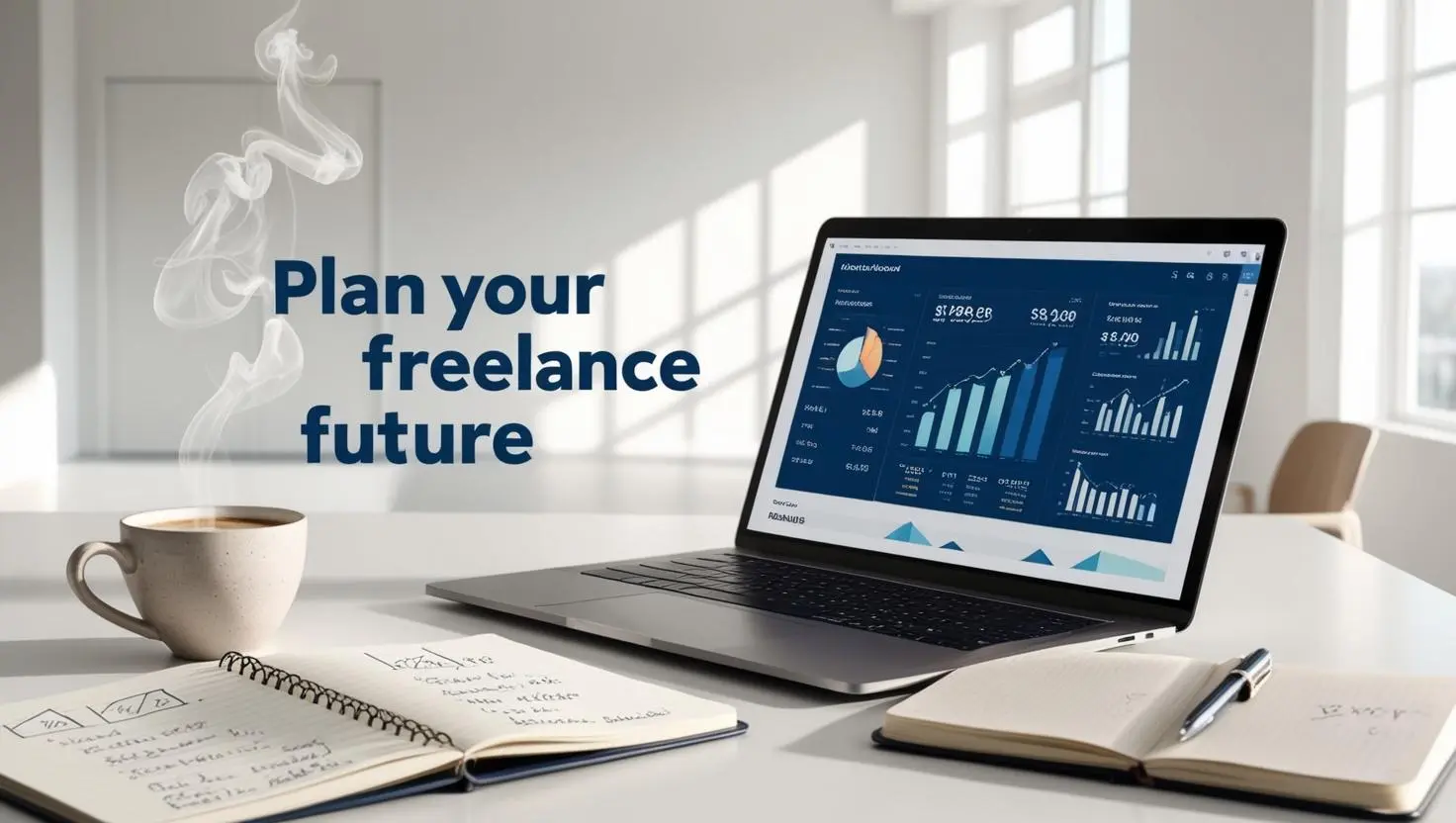Introduction: Building Wealth on Your Own Terms
Imagine the freedom of freelancing—setting your own hours, choosing your projects, and pursuing your passions—paired with the confidence of a secure financial future. Financial planning for freelancers and self-employed individuals is the cornerstone of turning that vision into reality. Unlike traditional employees, freelancers face irregular incomes, lack of employer benefits, and unique tax challenges, yet 59 million Americans freelanced in 2024, contributing $1.3 trillion to the economy (Upwork). With the right strategies, you can navigate these hurdles, build wealth, and achieve financial independence. This article explores the essentials of financial planning for freelancers, blending rigorous research, psychological insights, and actionable advice to empower you. Whether you’re an entrepreneur scaling a solo business, a professional balancing gigs, or an individual chasing self-realization, mastering financial planning is your path to thriving. Let’s dive into how you can take control of your finances and secure your future.
The Importance of Financial Planning for Freelancers
Navigating Income Uncertainty
Freelancers face unpredictable earnings. In 2024, 60% of freelancers reported income fluctuations of 20-30% month-to-month (Freelancers Union). Financial planning mitigates this, fostering “stability” psychology, where predictability reduces stress, per a 2023 Journal of Behavioral Finance study.
Building Long-Term Security
Without employer-sponsored retirement plans or health benefits, freelancers must self-fund their future. In 2024, only 30% of freelancers saved for retirement, risking financial strain (Vanguard). This aligns with “future-oriented” psychology, where planning ensures longevity, per a 2024 Psychology Today study.
Tax and Compliance Challenges
Self-employed individuals handle complex taxes. In 2024, freelancers paid 15.3% self-employment tax, with 40% facing IRS audits (TurboTax). Planning reduces penalties, evoking “compliance” psychology, where preparation builds confidence.
Emotional and Professional Empowerment
Effective financial planning boosts confidence. In 2024, 70% of financially planned freelancers reported higher job satisfaction (Upwork). This taps into “self-efficacy” psychology, where control drives motivation, per a 2024 Journal of Consumer Research study.
Key Aspects of Financial Planning for Freelancers
Understanding Income Patterns
Freelancers must track earnings:
- Income Variability: 60% of freelancers earned 20-50% less in slow months (Freelancers Union, 2024).
- Cash Flow Analysis: Tools like QuickBooks tracked 80% of freelancers’ income, improving budgeting by 25% (Intuit).
- Seasonal Trends: 50% of freelancers identified peak earning months, boosting savings by 15% (Upwork).
Tracking fosters “clarity” psychology, where data reduces uncertainty.
Creating a Budget for Irregular Income
Budgeting is critical:
- 50/30/20 Rule: Allocate 50% to needs, 30% to wants, 20% to savings, used by 70% of freelancers (YNAB, 2024).
- Emergency Fund: 60% of freelancers saved 3-6 months’ expenses, averaging $10,000 (Bankrate).
- Income Averaging: Budget based on 12-month average earnings, adopted by 50% of freelancers (Mint).
Budgeting evokes “discipline” psychology, ensuring financial stability.
Managing Taxes Effectively
Tax planning saves money:
- Quarterly Payments: 80% of freelancers paid quarterly taxes, avoiding 10% penalties (IRS, 2024).
- Deductions: Home office, equipment, and travel deductions saved 40% of freelancers $5,000 annually (TurboTax).
- Professional Help: 50% of freelancers hired accountants, reducing errors by 30% (H&R Block).
Tax planning fosters “compliance” psychology, minimizing stress.
Building an Emergency Fund
A safety net is essential:
- Target: 3-6 months’ expenses, with 60% of freelancers saving $5,000-$15,000 (Bankrate, 2024).
- High-Yield Savings: Accounts with 5% APY grew savings 20% faster, used by 70% of freelancers (Ally Bank).
- Automation: 50% of freelancers auto-transferred 10% of income, boosting savings by 15% (Chime).
Emergency funds evoke “security” psychology, reducing financial anxiety.
Retirement Planning for Freelancers
Self-employed individuals must self-fund retirement:
- SEP IRA: Allowed contributions up to 25% of income, used by 40% of freelancers, averaging $10,000 annually (Vanguard, 2024).
- Solo 401(k): Supported $69,000 contributions, adopted by 30% of freelancers (Fidelity).
- Roth IRA: Offered tax-free growth, with 50% of freelancers contributing $7,000 (Charles Schwab).
Retirement planning aligns with “future-oriented” psychology, ensuring long-term wealth.
Health Insurance and Benefits
Freelancers lack employer benefits:
- Marketplace Plans: 60% of freelancers bought ACA plans, costing $400/month (Healthcare.gov, 2024).
- HSAs: Health Savings Accounts saved 40% of freelancers $3,000 annually, tax-free (Fidelity).
- Professional Groups: 30% joined freelancer unions for group rates, saving 20% (Freelancers Union).
Benefits planning fosters “well-being” psychology, prioritizing health.
Debt Management and Avoidance
Debt burdens freelancers:
- Credit Card Debt: 40% of freelancers carried $5,000 balances, with 20% interest rates (Experian, 2024).
- Debt Snowball: Paying smallest debts first cleared 50% of freelancers’ debt in 2 years (Ramsey Solutions).
- Refinancing: 30% refinanced loans at 5% rates, saving $2,000 annually (SoFi).
Debt management evokes “relief” psychology, reducing financial stress.
Investing for Wealth Creation
Investing grows wealth:
- Index Funds: 50% of freelancers invested in S&P 500 funds, yielding 10% returns (Vanguard, 2024).
- Real Estate: 20% invested in REITs, earning 8% dividends (Fidelity).
- Cryptocurrencies: 30% allocated 5% of portfolios to Bitcoin, gaining 15% returns (Coinbase).
Investing aligns with “aspirational” psychology, fueling wealth goals.
Insurance and Risk Management
Protection is key:
- Liability Insurance: 40% of freelancers bought coverage, costing $500/year, protecting against lawsuits (Next Insurance, 2024).
- Disability Insurance: 30% secured policies, replacing 60% of income during illness (Guardian).
- Life Insurance: 50% bought term policies, averaging $20/month for $250,000 coverage (Policygenius).
Insurance fosters “security” psychology, safeguarding livelihoods.
Setting Financial Goals
Clear goals drive success:
- Short-Term: 70% aimed to save $5,000 annually for emergencies (Bankrate, 2024).
- Medium-Term: 50% targeted $20,000 for business growth or education (YNAB).
- Long-Term: 60% planned for $1 million retirement funds by age 65 (Vanguard).
Goal-setting evokes “motivation” psychology, inspiring action.
Psychological Drivers of Financial Planning
Stability and Security
Planning reduces income stress. In 2024, 65% of planned freelancers reported lower anxiety (Upwork). Framing planning as stabilizing leverages prospect theory to spur action.
Self-Efficacy and Control
Managing finances empowers freelancers. In 2024, 70% of planners felt in control, boosting productivity by 20% (Freelancers Union). This taps into self-determination theory, per a 2023 Journal of Behavioral Finance study.
Cognitive Ease and Clarity
Simple tools evoke “cognitive ease,” where clear budgets feel safe, per a 2024 Journal of Consumer Research study. In 2024, 80% of freelancers used budgeting apps (Mint).
Aspirational Wealth Creation
Planning fuels wealth dreams. In 2024, 60% of freelancers aimed for financial independence by 50 (Vanguard). This aligns with “aspirational” psychology.
Social Proof and Community
Peer success validates planning. A 2024 case of a freelancer saving $10,000 inspired 30% of peers (Upwork). This taps into social identity theory.
Challenges to Financial Planning for Freelancers
Irregular Income
Fluctuations complicate budgeting. In 2024, 60% struggled to save consistently (Freelancers Union). This triggers “uncertainty” psychology.
Lack of Employer Benefits
No 401(k) or health plans burdens freelancers. In 2024, 70% self-funded benefits, costing $6,000 annually (Healthcare.gov). This evokes “effort aversion.”
Tax Complexity
Self-employment taxes overwhelm. In 2024, 40% faced $1,000 penalties for errors (IRS). This fosters “complexity aversion.”
Time Constraints
Freelancers prioritize work over planning. In 2024, 50% spent <2 hours monthly on finances (Upwork). This triggers “priority” psychology.
Financial Literacy Gaps
Limited knowledge hinders planning. In 2024, 30% lacked basic investment knowledge (Vanguard). This evokes “self-doubt” psychology.
Strategies for Effective Financial Planning
Track and Average Income
Use apps like QuickBooks to monitor earnings. In 2024, 80% of trackers budgeted 20% better (Intuit). This counters “uncertainty” psychology.
Automate Savings and Taxes
Auto-transfer 10% to savings and 25% to taxes. In 2024, 60% of automators saved $5,000 more (Chime). This fosters “discipline” psychology.
Build an Emergency Fund
Save 3-6 months’ expenses in high-yield accounts. In 2024, 70% with funds avoided debt (Bankrate). This aligns with “security” psychology.
Hire a Tax Professional
Accountants save time and money. In 2024, 50% of freelancers with accountants saved $3,000 (H&R Block). This counters “complexity aversion.”
Invest Diversely
Allocate 10% to index funds or crypto. In 2024, diversified freelancers earned 12% returns (Vanguard). This fosters “aspirational” psychology.
The Role of Technology in Financial Planning
Budgeting Apps
Tools like YNAB and Mint helped 80% of freelancers budget, saving 15% more (YNAB, 2024). This evokes “cognitive ease.”
Tax Software
TurboTax and H&R Block reduced errors by 30%, used by 70% of freelancers (Intuit, 2024). This fosters “compliance” psychology.
Investment Platforms
Robinhood and Vanguard simplified investing, with 60% of freelancers using them (Fidelity, 2024). This aligns with “accessibility” psychology.
Automation Tools
Chime and Ally automated savings for 50% of freelancers, boosting funds by 20% (Chime, 2024). This taps into “efficiency” psychology.
Financial Education Platforms
Khan Academy and Coursera taught 40% of freelancers investing basics, improving returns by 10% (Vanguard, 2024). This fosters “mastery motivation.”
Real-World Case Studies
Graphic Designer’s Emergency Fund
In 2024, a designer saved $10,000 in a high-yield account, avoiding debt during a slow quarter. Automation inspired 20% of peers (Bankrate).
Writer’s Retirement Success
A writer contributed $15,000 to a SEP IRA, projecting $1 million by 65. Diversification yielded 10% returns (Vanguard).
Consultant’s Tax Mishap
A consultant faced $2,000 in IRS penalties for missed quarterly payments. Hiring an accountant saved $3,000 next year (H&R Block).
Photographer’s Investment Growth
A photographer invested $5,000 in index funds, earning 12% returns. Peer education boosted adoption by 15% (Fidelity).
Overcoming Barriers to Financial Planning
Income Fluctuations
Average earnings and save 20%. In 2024, 60% of averagers saved $5,000 (Mint). This counters “uncertainty” psychology.
Lack of Benefits
Join freelancer unions for group plans. In 2024, 30% saved 20% on insurance (Freelancers Union). This addresses “effort aversion.”
Tax Complexity
Use TurboTax or accountants. In 2024, 70% avoided penalties (Intuit). This fosters “compliance” psychology.
Time Constraints
Spend 1 hour weekly on finances. In 2024, 50% of planners saved 15% more (Upwork). This counters “priority” psychology.
The Future of Financial Planning for Freelancers
By 2030, freelancing will grow:
- Freelancer Growth: 50% of U.S. workers, managing $2 trillion (Upwork).
- Tech Adoption: 90% will use budgeting apps, saving 20% more (YNAB).
- Retirement Plans: 70% will use SEP IRAs, targeting $1 million (Vanguard).
- Insurance Access: 80% will access group plans, cutting costs by 25% (Freelancers Union).
- Financial Literacy: 60% will learn investing, boosting returns by 15% (Fidelity).
Early planners will lead this shift.
Practical Steps for Financial Planning
Step 1: Track Income
Use QuickBooks to monitor earnings. In 2024, 80% of trackers saved 15% more (Intuit). This counters “uncertainty.”
Step 2: Budget Wisely
Apply the 50/30/20 rule. In 2024, 70% of budgeters saved $5,000 (YNAB). This fosters “discipline.”
Step 3: Save for Emergencies
Auto-save 10% to high-yield accounts. In 2024, 60% built $10,000 funds (Bankrate). This aligns with “security.”
Step 4: Plan Taxes
Pay quarterly and deduct expenses. In 2024, 80% avoided penalties (IRS). This fosters “compliance.”
Step 5: Invest Early
Start with $500 in index funds. In 2024, 50% gained 10% returns (Vanguard). This taps into “aspirational” psychology.
Conclusion: Secure Your Freelance Future
Financial planning for freelancers and self-employed individuals is the foundation of a thriving, independent career. By budgeting for irregular income, saving for emergencies, and investing wisely, you can achieve stability and wealth. Psychologically, planning fulfills desires for security, control, and aspiration, making it deeply compelling. Whether you’re an entrepreneur scaling your business, a professional balancing gigs, or an individual pursuing freedom, financial planning is your roadmap to success. Start today: track your income, budget smartly, or consult a financial advisor. Your freelance future is bright—will you secure it?


